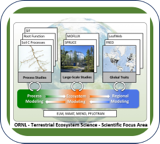The Enriched Background Isotope Study (EBIS) characterizes organic carbon flux from litter sources to mineral-soil sinks through the operation of a distributed enriched isotope study for eastern hardwood forests at AmeriFlux sites (EBIS-AmeriFlux). EBIS provides data on carbon flux for United States eastern hardwood forests necessary for testing process hypotheses and judging efficacy of soil C cycling models. We previously used 14C-enriched material collected from local releases of radiocarbon resulting in whole-ecosystem isotopic label near Oak Ridge, Tennessee (EBIS-Oak Ridge) to study fundamental terrestrial soil C cycle of upland forests (Trumbore et al. 2002; Hanson et al. 2005; Swanston et al. 2005; Gaudinski et al. 2009). In 2004 and 2005, new atmospheric pulses of 14CO2 on the Oak Ridge Reservation produced additional enriched plant material and the opportunity to deploy enriched materials for soil C cycle studies along a climatic gradient of AmeriFlux hardwood sites. EBIS-AmeriFlux was implemented to evaluate soil C cycles over a wider range of climatic, edaphic, and biological conditions. In fall 2007, we established enriched litter manipulations at four AmeriFlux sites that span the climatic extent of the eastern deciduous hardwood forests and are appropriate for testing our hypotheses related to climatic controls on soil C cycling processes. Experimental changes in 14C signatures from litter additions are obvious in the surface horizons after 2 years of manipulation. We have completed 4 applications of enriched litter to provide us with the strongest possible signal for quantifying transfer rates to the mineral soils.
EBIS-AmeriFlux field site treated with 14C-enriched material.

